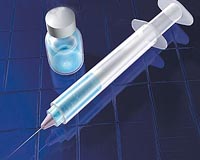| . |  |
. |
Boston MA (SPX) Nov 23, 2010 Boston University researchers have developed a simple diagnostic tool that can quickly identify dangerous viruses like Ebola and Marburg. The biosensor, which is the size of a quarter and can detect viruses in a blood sample, could be used in developing nations, airports and other places where natural or man-made outbreaks could erupt. "By enabling ultra-portable and fast detection, our technology can directly impact the course of our reaction against bio-terrorism threats and dramatically improve our capability to confine viral outbreaks," said Assistant Professor Hatice Altug of the Boston University College of Engineering, who co-led the research team with Assistant Professor John Connor of the Boston University School of Medicine. Traditional virus diagnostic tools are effective, but require significant infrastructure and sample preparation time. The new biosensor developed at Boston University directly detects live viruses from biological media with little to no sample preparation. The breakthrough is detailed in the Nov. 5 online edition of Nano Letters. From bird flu to H1N1, outbreaks of fast-spreading viral diseases in recent years have sparked concern of pandemics similar to the 1918 Spanish Flu that caused more than 50 million deaths. A significant fraction of today's viral threats are viruses that use RNA to replicate. Individuals infected with these viruses often show symptoms that are not virus-specific, making them difficult to diagnose. Among them are hemorrhagic fever viruses, such as Ebola and Marburg, which could be used as bio-warfare agents. Critical to identifying and containing future epidemics of RNA-based viruses is the development of rapid, sensitive diagnostic techniques that healthcare providers can quickly deploy so that infected individuals can be quickly identified and treated. Partly funded through the Boston University Photonics Center and the U.S. Army Research Laboratory, and working in collaboration with the U.S. Army Medical Research Institute for Infectious Diseases, the team has demonstrated reliable detection of hemorrhagic fever virus surrogates (i.e. for the Ebola virus) and pox viruses (such as monkeypox or smallpox) in ordinary biological laboratory settings. "Our platform can be easily adapted for point-of-care diagnostics to detect a broad range of viral pathogens in resource-limited clinical settings at the far corners of the world, in defense and homeland security applications as well as in civilian settings such as airports," said Altug. Connor noted an additional, significant advantage of the new technology. "It will be relatively easy to develop a diagnostic device that simultaneously tests for several different viruses," he observed. "This could be extremely helpful in providing the proper diagnosis." The new biosensor is the first to detect intact viruses by exploiting plasmonic nanohole arrays, or arrays of apertures with diameters of about 200 to 350 nanometers on metallic films that transmit light more strongly at certain wavelengths. When a live virus in a sample solution, such as blood or serum, binds to the sensor surface, the refractive index in the close vicinity of the sensor changes, causing a detectable shift in the resonance frequency of the light transmitted through the nanoholes. The magnitude of that shift reveals the presence and concentration of the virus in the solution. "Unlike PCR and ELISA approaches, our method does not require enzymatic amplification of a signal or fluorescent tagging of a product, so samples can be read immediately following pathogen binding," said Altug. Ahmet Yanik, Altug's research associate who conducted the experiments, added, "Our platform can detect not only the presence of the intact viruses in the analyzed samples, but also indicate the intensity of the infection process." The researchers are now working on a highly portable version of their biosensor platform using microfluidic technology designed for use in the field with minimal training.
Share This Article With Planet Earth
Related Links Boston University College of Engineering Epidemics on Earth - Bird Flu, HIV/AIDS, Ebola
 Economic Benefits Of Polio Eradication 50 Billion Dollars
Economic Benefits Of Polio Eradication 50 Billion DollarsBoston MA (SPX) Nov 23, 2010 A new study estimates that the global initiative to eradicate polio could provide net benefits of at least US$40-50 billion if transmission of wild polioviruses is interrupted within the next five years. The study provides the first rigorous evaluation of the benefits and costs of the Global Polio Eradication Initiative (GPEI)-the single largest project ever undertaken by the global health ... read more |
|
| The content herein, unless otherwise known to be public domain, are Copyright 1995-2010 - SpaceDaily. AFP and UPI Wire Stories are copyright Agence France-Presse and United Press International. ESA Portal Reports are copyright European Space Agency. All NASA sourced material is public domain. Additional copyrights may apply in whole or part to other bona fide parties. Advertising does not imply endorsement,agreement or approval of any opinions, statements or information provided by SpaceDaily on any Web page published or hosted by SpaceDaily. Privacy Statement |